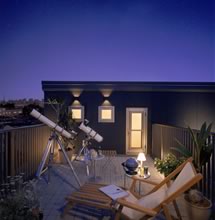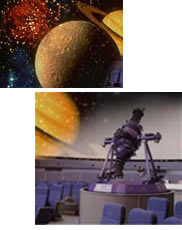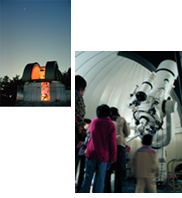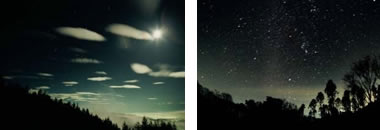Japanese | English
Japan Telescope Manufactures Association
Welcome to the sky-watching world.
Japan Telescope Manufactures Association
Those who make their home an astronomical observatory, who enjoy the starry night at ease.
In ancient civilization they also did celestial observatory. They knew the date and time according to the movements of celestial bodies. And they made an agricultural calendar to know when to seed etc. Moreover a megalithic monument such as Stonehenge has a construction which shows how they observed the vernal equinox and the autumnal equinox. With the development of maritime trade, the stars were used as a landmark for directions.
And now, we made private observatories on our verandas. Some hard celestial fans observe the Sun, the moon, heliospheric planets and other galaxies. Some hobby-star gazing fans enjoy looking up the night sky with a telescope or binoculars and watching the moon, planets, milky way and various shining stars.
Star gazing as a hobby does not need special knowledge; it's a world you can enjoy with knowledge of famous stars' locations and constellations.
At first you can enjoy just going to a planetarium with your family, being surprised at the ring of the Saturn or the striped pattern of the Jupiter to high-powered telescope of local observatories, learning how to find the Milky Way and the North Star, the shape and names of constellations and the romantic stories associated with them.
To those who are about to start star gazing.
 Go to a planetarium with your family.
Go to a planetarium with your family.
The first step to enjoy the starry sky is to go to a planetarium nearby. You can see the seasonal stars on the roof of heaven. Sometimes a newly-discovered galaxy or a cutting-edge astronomical theory is explained. The latest planetarium can satisfy even your science curiosity.
If you get a star plate, you can easily find the constellations in the north, south, west and east sky tomorrow night.
See the star gazing spot page for nearby planetariums
 Next, let's take part in a star gazing party hosted by an astronomical observatory etc.!
Next, let's take part in a star gazing party hosted by an astronomical observatory etc.!
National Astronomical Observatory of Japan Mitaka Campus holds star gazing parties twice a month; the night before the second and the fourth Saturday. The booking time is 19:30 ∼ 20:30 in the summer time (Apr. ∼ Sep.) and 18:30 ∼ 19:30 in the winter time (Oct. ∼ Mar.) Neither an appointment in advance nor participation fees are needed. After you listen to the short explanation of the astronomical object of that day in a hall, you observe the heavenly body. A 50cm-telescope will lead you to space. You can enjoy the crater of the moon, the ring of the Saturn, the Milky Way and the flamboyant cluster of stars with your own eyes. (Picture of the institute:photo by Yutaka Iijima)
Check the real stars you have just seen from pictures. See the star gazing spot page for the information of across-the-country institutes and star gazing parties.
Go for the real night sky! If possible go out to the suburbs when there is not the moon.
The fundamental of star gazing is doing in a broad space on a fine night. When you get accustomed to a dark place (adaptation to darkness) you can see more stars. It takes about 10 ∼ 30min. A minor light will return your eyes the previous state. To light a Maglite or a car light is bad manners. Be careful.
During the star gazing, in case you use a Maglite to see a star plate, it is polite to cover the light with red cellophane to minimize the light quantity. The backlight of a cell phone is unexpectedly bright, so be careful.
The lights of a city have influence even it is away for as few as 10km. It is preferable to go to a high place away form a big city.

We cannot see the stars well at moonlit night At night as near as the new moon
![]() The number of stars at night.
The number of stars at night.

We have a phrase “as abundant as the stars” pronominalizing the numerous and uncountable things. But we can see an unexpectedly small number of stars by the naked eye.
With the unassisted eye, we can see 21 stars of the first magnitude, 67 stars of the second magnitude, 190 stars of the third magnitude, 710 stars of the fourth magnitude, 1100 stars of the fifth magnitude and 5600 stars of the sixth magnitude. So you can see about 8600 stars in total. With the naked eyes, you can see the third magnitude stars in most in urban cities; but you can see only half of them on the horizon at a time. So it is better to count 100.
If you go to a place the sky is clear, you can see stars of the fifth and sixth magnitude. Even so, you can only see about 4000 at a time. What do you think? Though we say “as abundant as the stars”, we can see with our naked eyes less stars than we expected, can’t we? (Reference : OS publication / How to be a maven of stars and space)
![]()
The criteria of the brightness of stars starts form the sixth.
By the way do you know how the stellar magnitude such as first or second has been decided? An ante-Christum Greek astronomer Hipparchus is said to indicate the brightness by the stellar magnitude. He decided the faintly visible stars the stars of the sixth magnitude. He determined the next brighter stars fifth, fourth ....and the brightest stars the first.
This criterion was used for a long time, and in about 1830 stars brightness was measured scientifically. As a result, one difference of the magnitude shows about 2.5 times difference. So the first stars are about 100 times brighter than sixth stars by 5th power 2.5.
Incidentally the brighter star than the first one is called the 0th, the -1th, and the -2th. The Sun is -26.8; the moon is -12.6, Venus -4.7, Mars -3.0, Jupiter -2.8, and Mercury -2.4. We know how bright they look, can’t we? (Reference : OS publication / How to be a maven of stars and space)